- eISSN 2353-8414
- Tel.: +48 22 846 00 11 wew. 249
- E-mail: minib@ilot.lukasiewicz.gov.pl
Zmiany warunków wynajmu mieszkania oczekiwane przez studentów po pandemii COVID-19 w związku z ich aktywnością na rynku pracy
Małgorzata Grzywińska-Rąpca1*, Mariola Grzybowska-Brzezińska2, Marcin Janusz3
1Uniwersytet Warmińsko-Mazurski w Olsztynie, Wydział Nauk Ekonomicznych, Katedra Rynku i Konsumpcji, Plac Cieszyński
1/429A, 10-719 Olsztyn
2Uniwersytet Warmińsko-Mazurski w Olsztynie, Wydział Nauk Ekonomicznych, Katedra Rynku i Konsumpcji, Plac Cieszyński 1/426, 10-719 Olsztyn
3Uniwersytet Warmińsko-Mazurski w Olsztynie, Wydział Nauk Ekonomicznych, Katedra Polityki Gospodarczej, ul. M. Oczapowskiego 4/105, 10-719 Olsztyn,
1*E-mail: malgo@uwm.edu
ORCID: 0000-0003-2088-2795
2E-mail: margrzyb@uwm.edu
ORCID: 0000-0002-6571-1140
3E-mail: marcin.janusz@uwm.edu.pl
ORCID: 0000-0002-4652-6898
DOI: 10.2478/minib-2023-0020
Abstrakt:
W artykule przedstawiono oczekiwania studentów dotyczące zmian na rynku mieszkaniowym po pandemii COVID-19. W związku z pandemią w wielu krajach wprowadzono ograniczenia i zmiany w różnych dziedzinach życia, co odbiło się na rynku najmu. Konieczność przejścia na nauczanie zdalne bardzo często wiązała się z koniecznością zmiany miejsca zamieszkania lub powrotu do domu rodzinnego uczniów. Było to bezpośrednio lub pośrednio związane z ich sytuacją ekonomiczną, która uległa pogorszeniu z powodu utraty pracy lub konieczności zmiany pracy. Przygotowując narzędzie badawcze skupiono się więc na subiektywnych oczekiwaniach studentów dotyczących warunków najmu po pandemii, dotyczących nie tylko kosztów najmu, ale także zmian w umowach najmu. W okresie badania respondenci uczyli się już zdalnie, więc można założyć, że opracowali już pewne strategie i taktyki dotyczące zagadnień objętych badaniem. Celem artykułu jest zasygnalizowanie i zobrazowanie za pomocą dostępnych danych zróżnicowania oczekiwań dotyczących opłat i zapisów w umowach najmu, z uwzględnieniem cech demograficznych i ekonomicznych respondentów. Celem badania było nie tylko wykazanie różnorodności oczekiwań dotyczących zmian miejsca zamieszkania, warunków najmu czy wysokości opłat spowodowanych pandemią, z uwzględnieniem zatrudnienia i płci badanego, ale także uwzględnienie jego aktywności na rynku pracy.
MINIB, 2023, Vol. 50, Issue 4
DOI: 10.2478/minib-2023-0020
Str. 1-20
Opublikowano 13 grudnia 2023

Zmiany warunków wynajmu mieszkania oczekiwane przez studentów po pandemii COVID-19 w związku z ich aktywnością na rynku pracy
Introduction
The housing market in university cities is characterised by high dynamics and a classic economic response to external factors. The occurrence of the COVID-19 pandemic meant that it began to change rapidly with the introduction of the first restrictions. The transition of students to a remote form of education, often the loss of a job were the biggest factors affecting the demand and supply of residential real estate. The loss of additional income from work during their studies meant that students were forced to change their place of residence and often return to their family home. One would expect that with reduced demand, the availability of premises would increase, but after a short 'shock’, the situation on the rental housing market in university cities stabilised and the real estate market returned to normal functioning with all its advantages and disadvantages. Interest in the presence of students in academic cities and their impact on the transformations taking place in them is consistently growing (Brooks, 2006; Munro et al., 2009). This is because, the demand reported by this social group concerns many areas of socio-economic life. The presence of students in cities primarily generates traffic in the real estate market, which is associated with the need to find a place to live for the duration of their studies. The demographic structure of cities and the local labour market is also not indifferent to the influx of young people to the city. With the constant number of students in the city, the demand for goods and services is changing, mainly in terms of living conditions, consumption, and participation in culture (Holdsworth, 2006). As a consequence, for several years, the literature on the subject has been discussing the multi-area impact of students on academic cities, which is referred to as studentification (Grzywińska-Rąpca et al., 2021; Nakazawa, 2017). The comprehensive, holistic impact of students on cities was written about at the beginning of the twenty-first century by m.in. Allinson (2006), and further developed, among others, by Kinton et al. (2018 ).
The aim of the study was to demonstrate the relationship between respondents’ assessments regarding: (1) changes in place of residence, (2) changes in the level of apartment rental fees, and (3) the impact of the pandemic on changes in the level of apartment rental fees. The study examined the relationships between respondents’ demographic characteristics and their assessments of their housing situation. As part of the main objective, the following research questions were asked: (1) What is the structure of assessments regarding changes in place of residence, taking into account the demographic characteristics of respondents? (2) What is the structure of assessments regarding changes in the level of apartment rental fees, taking into account the demographic characteristics of respondents? (3) What is the structure of assessments regarding the impact of the pandemic on changes in the level of apartment rental fees, taking into account the demographic characteristics of respondents? (4) Do demographic characteristics and economic activity of respondents differentiate their assessments of their housing situation?
This study, both in its cognitive and application parts, can be a source of knowledge and popularisation of research and can be a source of inspiration for in-depth scientific considerations and discussions. The analysis of the relationship between respondents’ demographic characteristics and their assessments of their housing situation presented in the publication may complement existing studies on the impact of respondents’ characteristics on subjective assessments of market behaviour. Subjective assessments of the housing situation may be taken into account to monitor and shape the housing market in academic centres.
Literature Review
As young people move to strong, academic urban centres, brain drain occurs (Docquier & Rapoport, 2012) in peripheral areas. On the other hand, many students after finishing their education decide to stay in the academic city to continue their professional activity here. Winters (2010) even states that the influx of young people affects the development of smart specialisations, contributing to the sustainable development of cities, making them even smarter.
As mentioned above, the influx of students into cities shapes demand in the local housing market. In general, the choice of a place to live boils down to two possibilities. The first is the housing stock at the disposal of the university. However, as the number of students increased, the housing base usually remained stable. Therefore, in the long run, not everyone interested in living in a student dormitory received such an opportunity. This is a global problem (see m.in. La Roche et al., 2010; Morris et al., 2020; Sotomayor et al., 2022). As a consequence, increased interest was observed in the open housing market, mainly in the rental market. Here, in turn, students usually have the choice of living independently in a rented apartment or co-living in one apartment with several people. The most popular are usually properties located in the immediate vicinity of the university, well connected with the place of education and public transport centres (stations, multi-modal transport transfer points, etc.) (Głuszak & Małkowska 2017).
The presence of students in cities translates into stable housing demand. Living costs, including apartment rentals, are part of the strategies of universities located in individual cities (Domański, 2022). Despite the primacy of private property in the Polish real estate market, academic cities are the places where surplus financial resources are invested in real estate. Properties are then intended for rent. In developed economies, the rental housing market is an important part of the market, dynamising, as Cesarski (2013) emphasises, the economy thanks to the multiplier effect. A wide range of apartments for rent (not only for 'students’) promotes the mobility of the workforce and improves the decisions of households when they are unable to meet their housing needs based on ownership.
The coronavirus pandemic has radically changed the situation of cities and the students living in them. A kind of 'closure’ of economies, minimising the functioning of many industries and moving away from traditional, stationary learning to remote learning caused many perturbations in academic life. Many students living in student dormitories or apartments for rent faced the decision to return to their family home or stay there (Birmingham et al., 2021). In view of online education and in most cases, the lack of earning opportunities, many of them decided to return to their towns (AMRON, 2021; Źróbek-Różańska, 2021, 2022). Researchers of the pandemic period attempted to diagnose the situation of students during this period. Farris et al. (2021) described students’ concerns about the possibility of becoming infected, the impact on the quality of education, which was related to the loss of employment and the need to make housing decisions. Similar results were presented by Iglesia and Lu (2021) in a review of studies documenting the distractors of student life during the COVID-19 pandemic. Long-term isolation and the need for many household members to stay in one apartment (even after returning to the family home) generated both positive and negative consequences (Kajta et al., 2023).
The outflow of students from academic cities has affected local markets, both real estate and the labour market. Rental rates on the rental market have decreased (Borzym, 2022; Mohammed et al., 2021), and the location of real estate near the university headquarters was not an important attribute during the pandemic (Głuszak & Belniak, 2020; Tomal & Helbich, 2022; Tomal & Marona, 2021; Źróbek-Różańska, 2022). The continuing time of the pandemic and isolation caused the loss of job among a large part of students (Oleszczyk, 2022; Rutkowski, 2020; Wronowska, 2021). This was a consequence of students leaving the academic city or closing the entities employing them (Wronowska, 2021).
Bearing the above in mind, the aim of this article is to indicate the relationship between students’ decisions related to residence and their activity on the labour market. According to the best knowledge of the authors, such a relationship has not been verified empirically in Poland so far.
Research Methods
Statistical analysis of data from the survey was carried out using correspondence analysis. This method is useful as an exploratory technique for revealing profiles in data and determining the nature of relationships. It belongs to one of the many specialised methods of data mining. The method is characterised by a wide range of applications and the possibility of a graphical presentation of test results. The statistics obtained as a result of the research procedure enable accurate recognition of the coexistence of categories of variables or objects. The most important steps in the correspondence analysis procedure are:
- Verification of hypotheses about independence adopted for the analysis of features (rejection of the hypothesis of independence),
- Determination of row and column profiles and parameters describing the quality of dependencies,
- Presentation of row (column) profiles in the space generated by columns (rows) of the correspondence matrix, and
1. Reduce the dimension of the space and create a common profile of rows and columns (Stanisz, 2007). Due to the minimal assumptions regarding the measurement properties of data and the possibility of using it on small data sets, this analysis is common in marketing analyses (study of similarities and associations between attributes and brands, market segmentation (Gursoy & Chen, 2000), brand positioning (Berthon et. al., 2001), positioning of a product or service in promotion, sales and advertising (Javalgi et al., 1995), and the separation of consumer profiles (Areni et al., 1998) and social sciences (Hoffman & Franke, 1986). The advantage of this method is the ability to describe relationships between two or more categorical variables (Beldona et al., 2005, Calantone et al., 1989, Malhotra et al., 2004). Polish researchers include, m.in: Stanimir (2005) in economic research, Górniak (2000) in social and marketing research, and Trzęsiok (2016), which used this method in measuring the confidence of financial institutions.
In this study, the analysis of correspondence was used to determine the correlations between the characteristics of respondents and their assessments regarding changes in residence, expectations regarding provisions in lease agreements, and changes in the level of housing fees caused by the pandemic situation.
One of the aims of the study is to demonstrate the relationship between the situation in the labour market of students (employment or lack of employment), gender, and changes in their housing situation. To mine the primary data from the questionnaire, the correspondence analysis used allowed to identify the structure of relationships between the studied variables and to present, without distortion in two-dimensional space, the original configurations of points representing the studied variables. The survey questions concerned the socio-economic situation of students with particular emphasis on the housing situation. First of all, they wanted to know the housing conditions of students and the changes caused by the pandemic. Then, the share of housing expenses in the students’ household budget was taken into account and, again, the changes that were triggered by the COVID-19 pandemic. As a consequence, students’ preferences related to the choice of place and method of residence and preferred provisions in lease agreements were learned.
Results and Discussions
The research was conducted in May 2021 on a sample of 391 students of the University of Warmia and Mazury in Olsztyn. The estimated values of basic macroeconomic indicators for this period prove that the crisis caused by the COVID-19 epidemic may cause many adverse changes in various areas of life. It can therefore be assumed that the date of the study is an appropriate date for analyses allowing for the diagnosis of students’ behaviour regarding changes in the housing market, labour market, and changes in shopping behaviour.
A study on changes in student behaviour regarding changes in the housing market, labour market, and changes in shopping behaviour was conducted in May 2021 among students of the University of Warmia and Mazury in Olsztyn. The respondents were undergraduate, engineering, and graduate students. The research tool was the author’s questionnaire. The frequency of responses in the area of the respondents’ housing situation indicates that there is a variation both by employment and gender of the survey participant (Table 1).
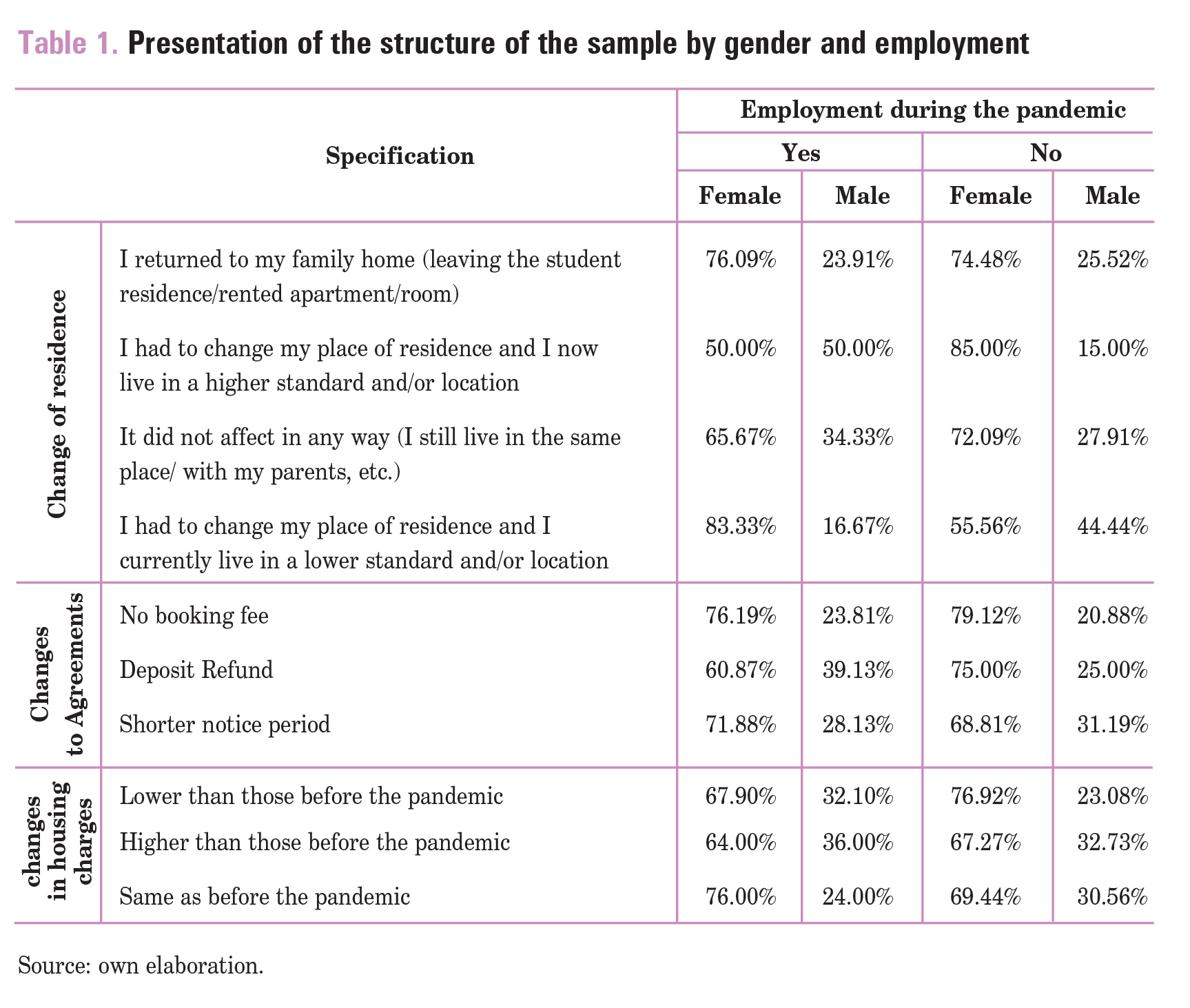
The majority part of students came to Olsztyn from the region and surrounding cities and towns. Only for some, it was associated with taking possession of real estate, for the vast majority, it was related to the search for a flat offered from university resources (mainly, student houses with a limited number of places) and apartments for rent available on the open market. The latter option made it possible to search for apartments on the rental market exclusively for personal use, and to settle the stock together with other landlords, where at that time, a room remained at the exclusive disposal (sometimes, even shared), while rooms such as a kitchen, dining room, or bathroom were available to all co-residents. It is still a popular form of residence during studies.
Therefore, in the situation of suspension of full-time teaching and the transition to remote learning, only a few (determined by factors other than learning) decided to stay in the previously inhabited resources. As can be seen from Table 1, the professional activity of students did not play a significant role here, because very often, the place of employment (trade, services, and catering) of students was also closed. For this reason, the vast majority of students decided to return to their hometowns. This unusual situation caused by the pandemic forced the need to terminate lease agreements satisfying both parties. For this reason, respondents in their declarations pointed to the need to adapt to the lease agreements constructed so far to future, undesirable, and unexpected events. In this case, as shown in Table 1, students who are not professionally active showed greater sensitivity, relatively more often indicated the possibility of efficient recovery of the deposit and other financial outlays incurred earlier.
The results of the correspondence analysis together with generalised singularities and eigenvalues are summarised in Table 2.
Based on the results presented in Table 2, it can be seen that successive dimensions (which are orthogonal to the others) explain smaller and smaller parts of the total value of the chi-squared statistic (and thus inertia). The first dimension allows 76.16% of total inertia to be reproduced, and the included second dimension increases the percentage of explained inertia to 99.87% of total inertia. Therefore, on the basis of this criterion, it is advisable to place the profiles in two-dimensional space. The row and column coordinates presented in Table 3 indicate that the highest value of mapping quality was obtained in the case of the group of women who were not employed during the pandemic (0.999) and for the group declaring the variant of change of residence caused by the pandemic: I returned to my family home (leaving the student dormitory/rented apartment/room) (0.999).
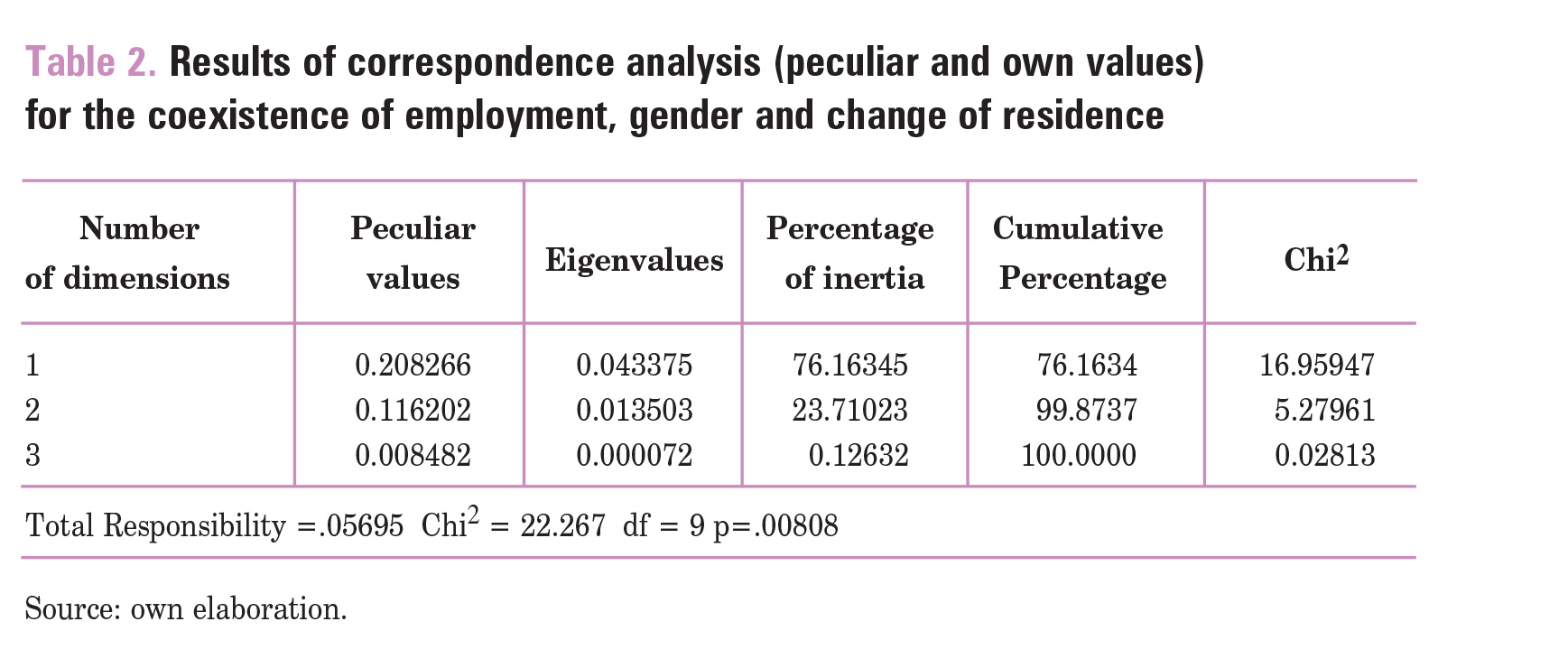
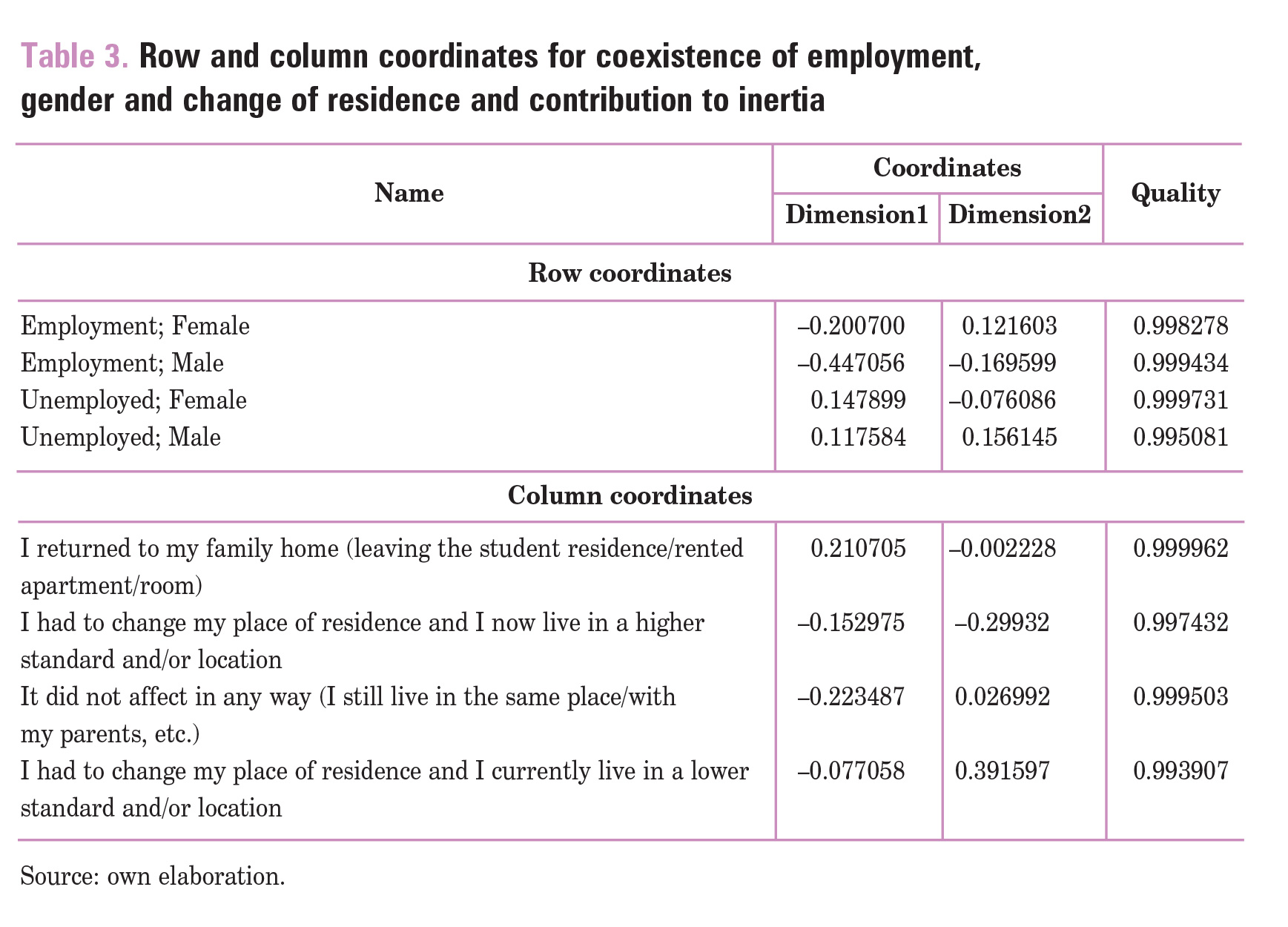
High-quality values (Table 3) for all coordinates (row and column) indicate that there is a high representation of rows and columns by points in two-dimensional space and this means that the original configurations of points have undergone minimal distortion in factorial space. The points representing gender and employment as well as changes in housing conditions declared by respondents were placed in a space defined by two dimensions (Figure 1).
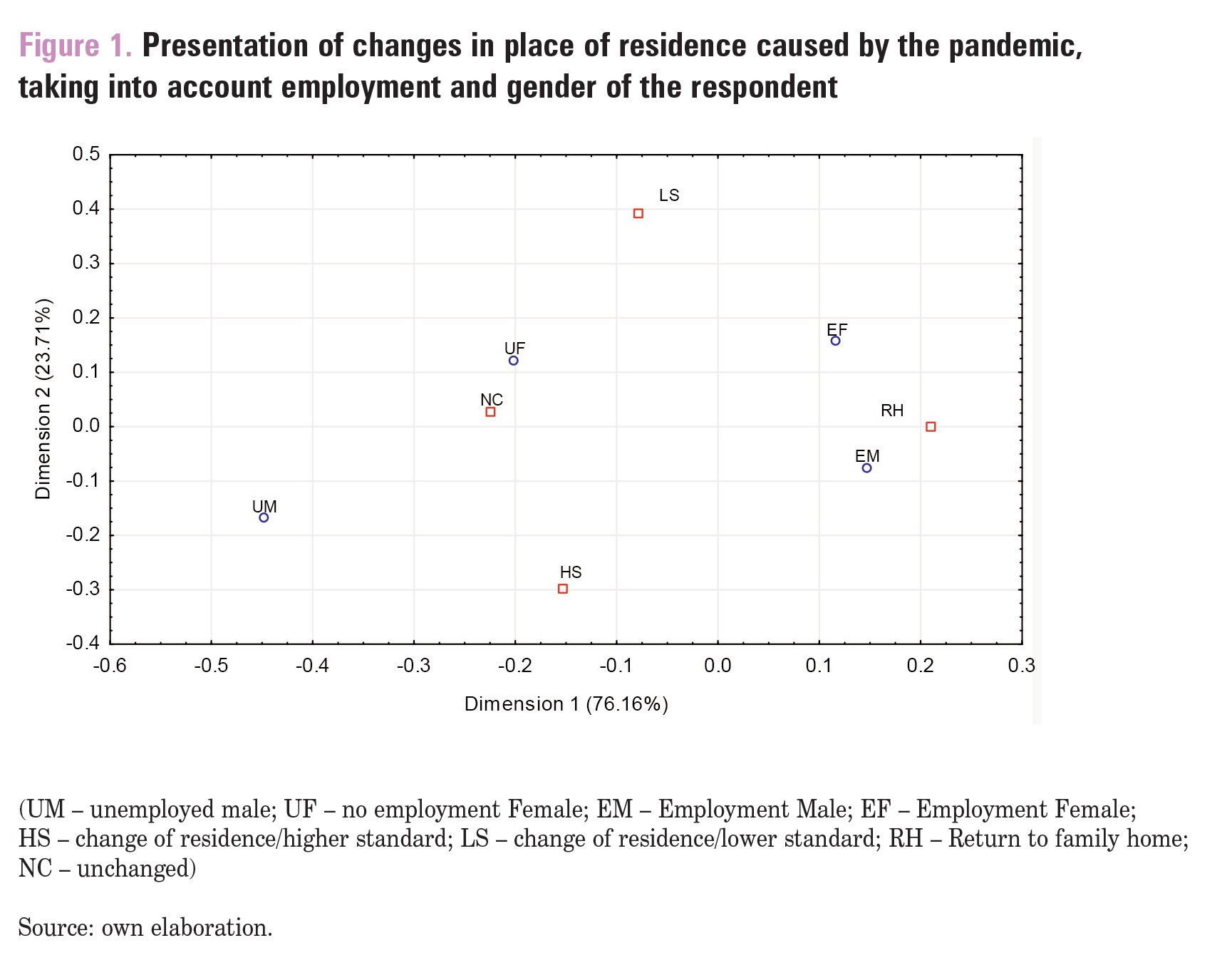
The points near the centre of the system (centroid) represent profiles similar to the average profiles in the entire dataset. The most typical groups of women who were not employed during the pandemic can be considered as the most typical in terms of declared changes of residence. The closest to this row point is the column point: return to the family home.
Another analysis concerned the interdependence of respondent’s characteristics (employees and gender) and expected changes in the provisions of the lease agreement. The first dimension allows 59.97% of total inertia to be reproduced and the second dimension increases the percentage of explained inertia to 100% of total inertia (Table 4).
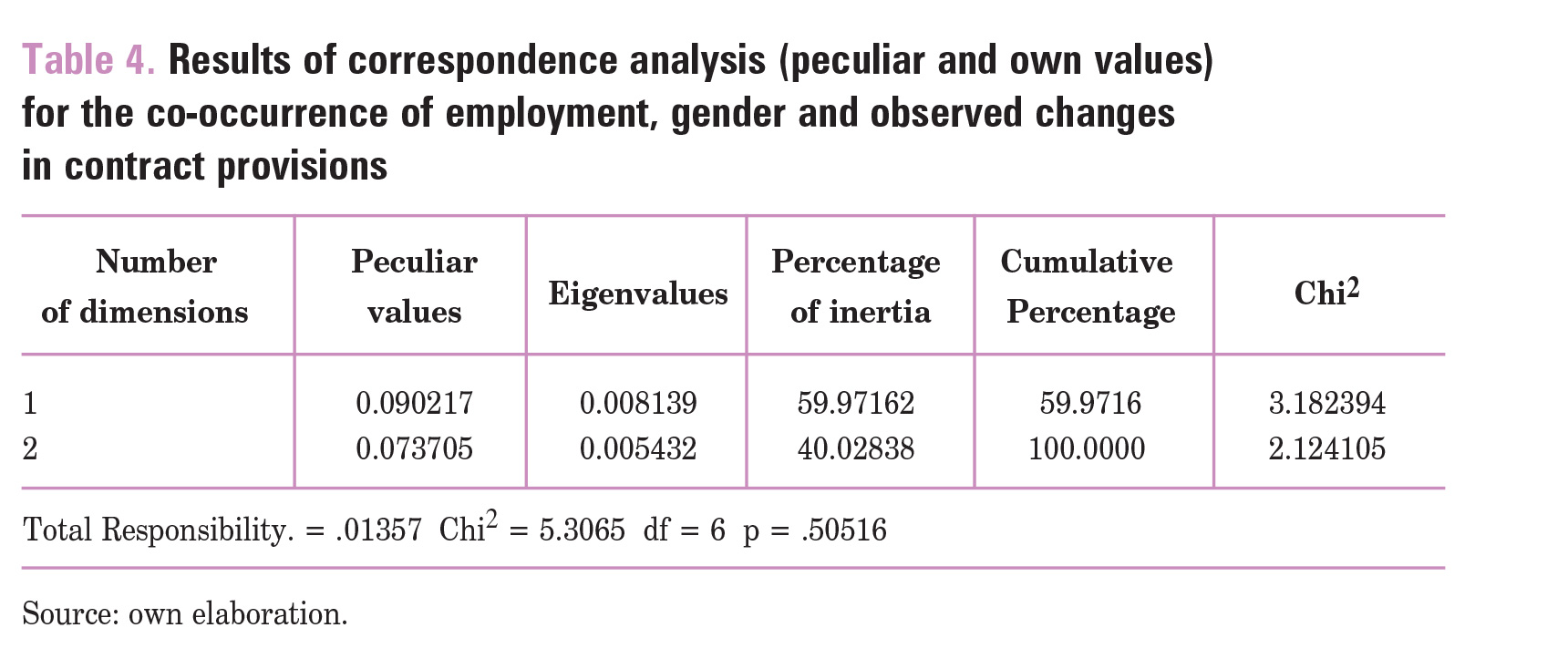

Therefore, on the basis of this criterion, the location of profiles in twodimensional space is doomed. The further part of the correspondence analysis presented in Table 5 provides information on the role of individual objects and variables in creating the system of the first two factorial axes and the quality of mapping the original configuration of points representing objects and variables by these factors. The quality values presented in Table 5 provide information about the relative amount of information that rows and columns contribute to the data set. The values of the quality level were recorded in all cases equal to unity, which means that in this case, the original point configurations did not undergo any distortion in the factorial space. Relative inertia values indicate the share of row and column points representing individual respondents (rows) and variants of expected changes in provisions in contracts (columns). By far, the largest shares are employed here by women. The values of relative inertia in the column indicate that the expectation of a shorter notice period had the greatest contribution to the formation of factorial space. The points representing row and column profiles are presented in a graphic form in the form of a two-dimensional factorial space (Figure 2), which indicates that the most typical profiles are unemployed women waiting for provisions in contracts excluding reservation fees (answer variant: no reservation fee).
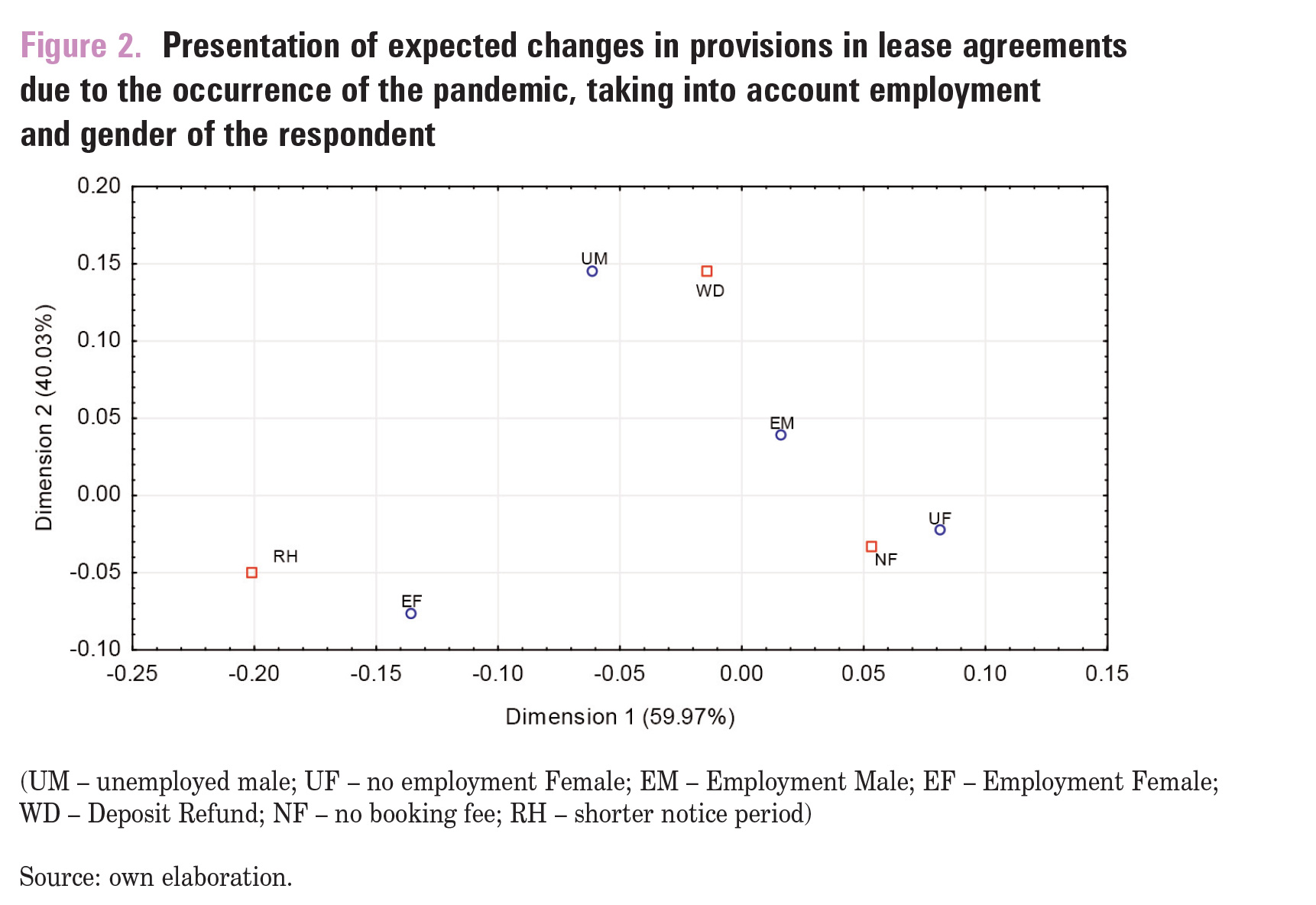
An important issue in the context of the housing situation of students during the pandemic is the level of housing expenses. Another analysis concerned the observed changes in housing fees taking into account the employment and gender of respondents. For the purpose of verifying the assumption about the dependence of the characteristics of changes in the level of housing charges, the following hypotheses were formulated: H0: the assessment of the level of changes in housing charges does not depend on the presence of employment and the gender of the respondent, and H1: the assessment of the level of changes in housing charges depends on the presence of employment and the gender of the respondent. The value of the c2 statistic, the significance level, and the critical value allowed to reject the null hypothesis, and the determined eigenvalues (Table 6) indicated the possibility of presenting the relationship between the characteristics of the level of changes in housing charges and the characteristics of the respondent in a two-dimensional system (dimension 1: 86.95%, dimension 2: 13.05%). After rejecting the null hypothesis, the coordinates and contribution to inertia for rows and columns were determined (Table 7).
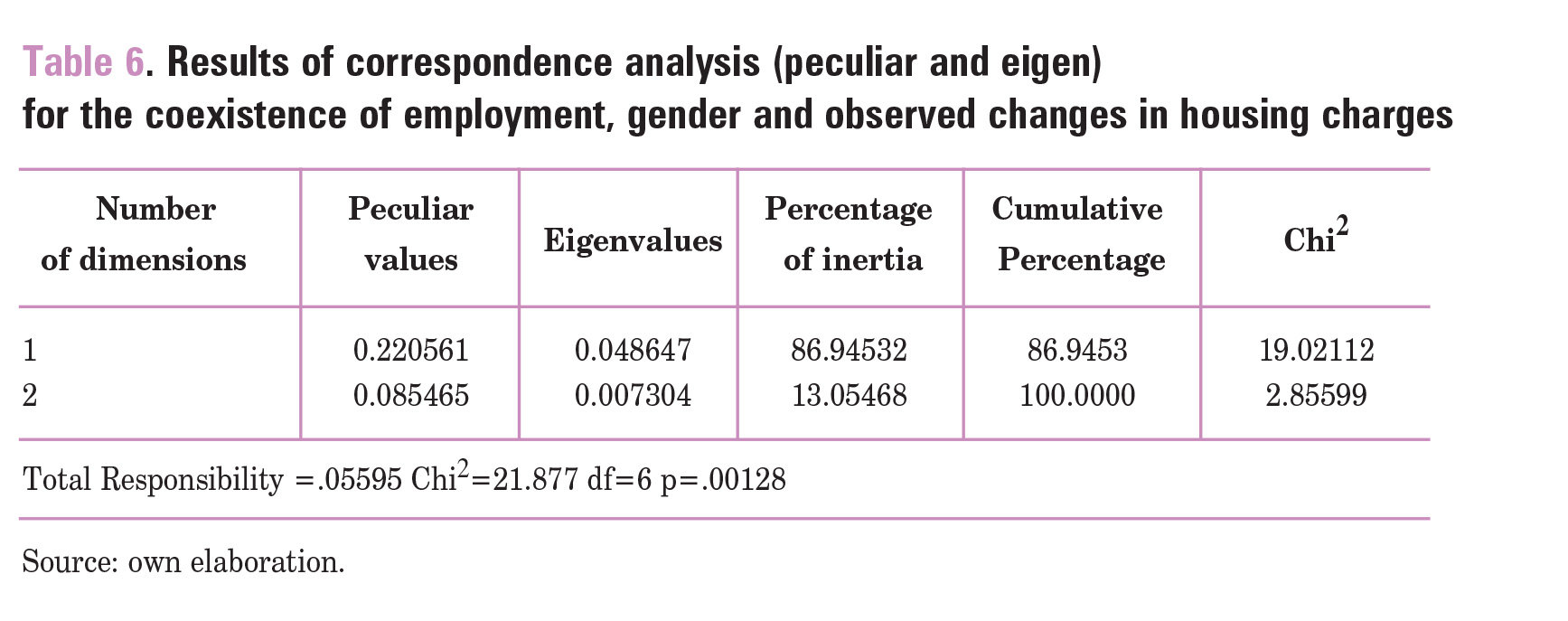
The values presented in Table 7 are the relative amount of information that rows and columns contribute to the data set. The determined values, both for row coordinates and column coordinates, indicate that the original point configurations have not been distorted in factorial space. The points representing row and column profiles are presented graphically in the form of a two-dimensional factorial space (Figure 3).
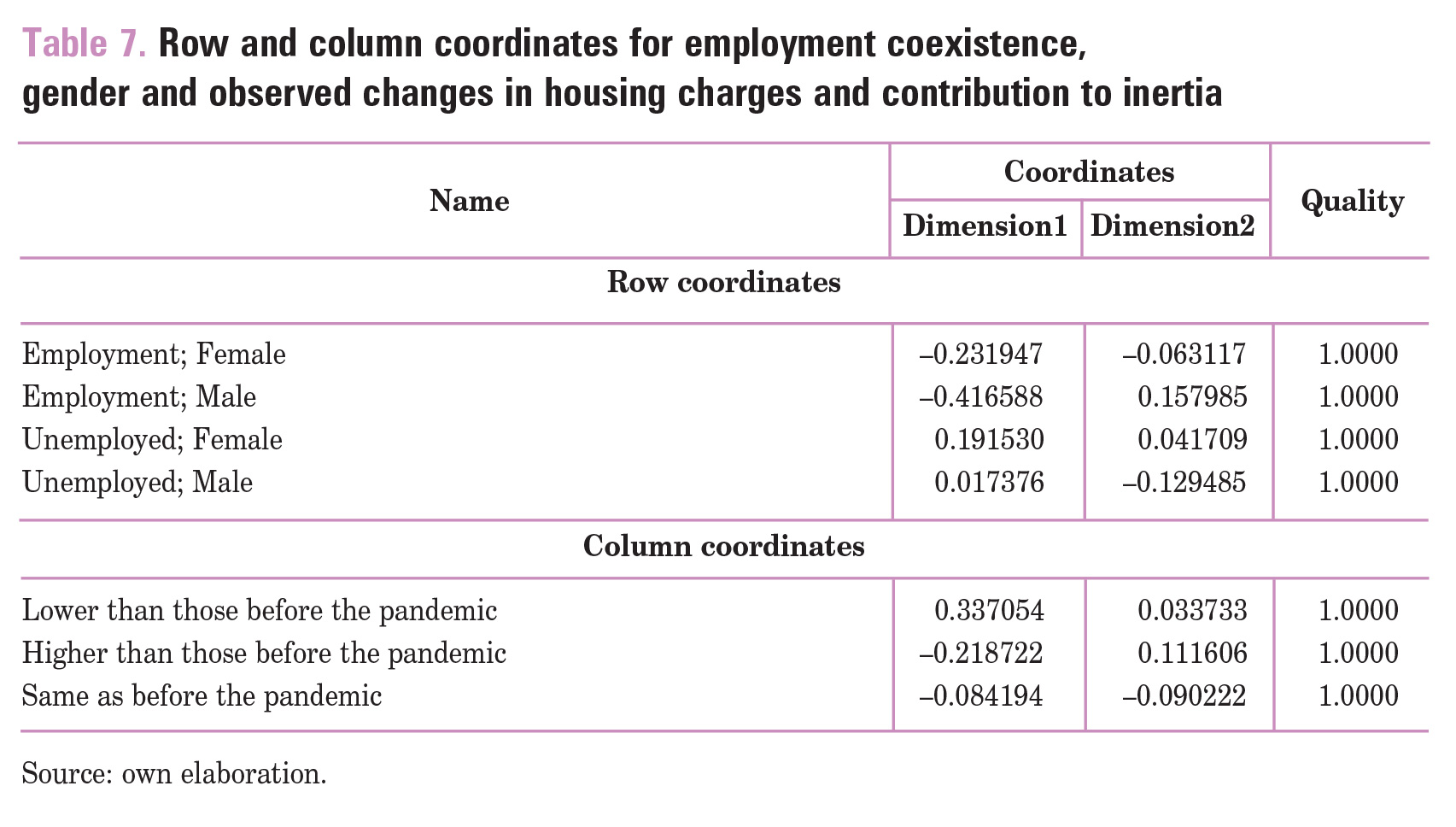
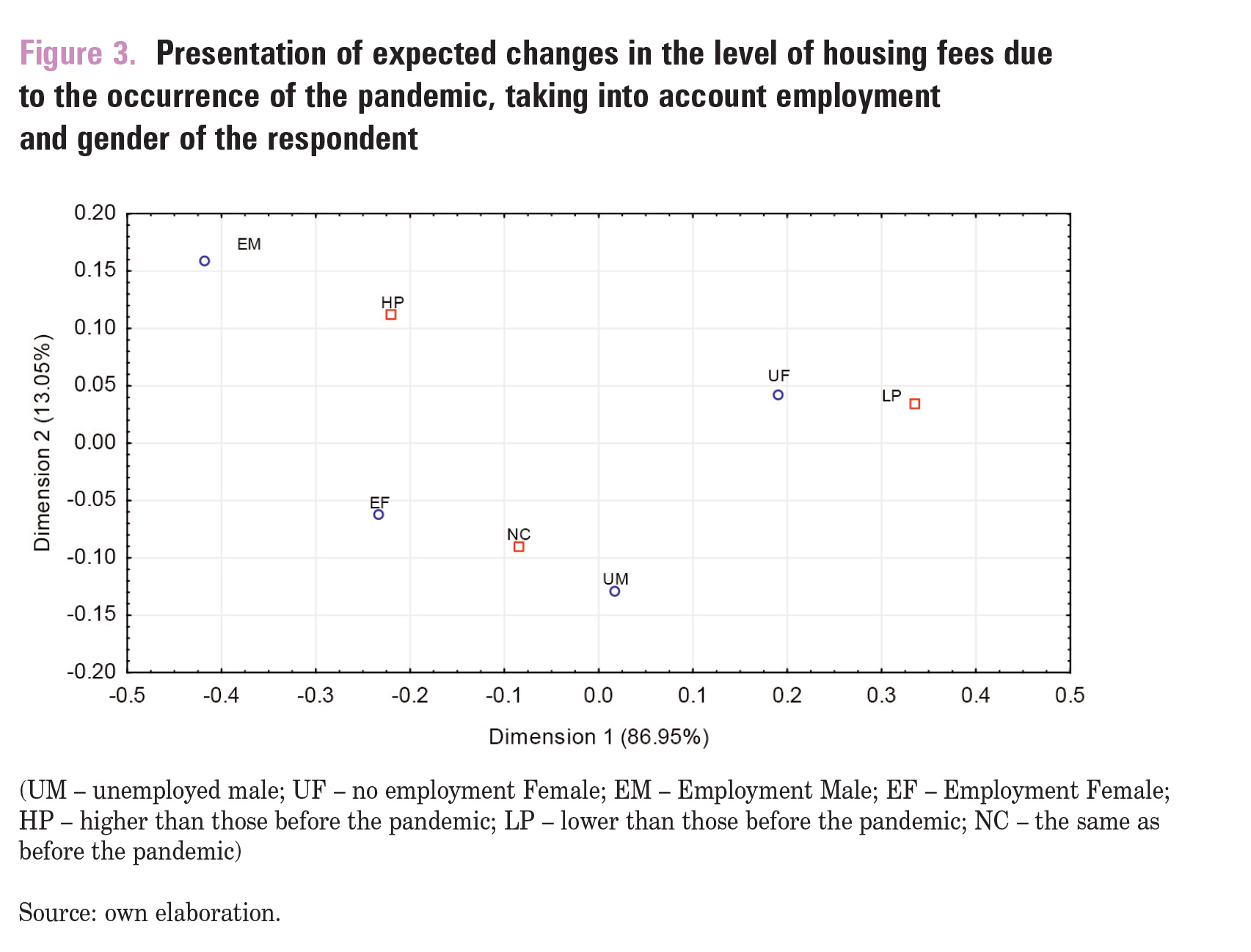
Based on the scatter analysis, 'similar’ respondents were grouped according to the aspect considered. In the third figure, the following groups can be identified: Women employed, unemployed men indicating no change in the level of housing charges; Unemployed women citing lower fees than before the pandemic; Men employed during the pandemic indicating a level of fees higher than before the pandemic. The points closest to the centre of the projection are the first group (employed women, unemployed men indicating no change in the level of housing charges). This group can be considered typical.
Conclusions
Changes in the rental housing market caused by the COVID-19 pandemic can be considered short-term changes. The reason for this may be the fact that the housing market in Poland is characterised by a constant shortage of apartments, high purchase prices, and interest rates unfavourable to borrowers. As reported by Lis (2019), housing needs and their changes are key determinants of setting the main objectives of housing policy. The assessment of housing needs from the perspective of housing policy is made from the outside in an aggregated manner, and not by taking into account the individual needs of tenants. As a consequence, a disconnect may arise between individual expectations and the housing needs of a given community. As early as 1995, Levine (1995) emphasised that expectations regarding rental housing should be closely related to the possibility of choice. In the area of satisfying housing needs, there may be some restrictions of choice due to wealth (Lee et al., 2022). Conducting a survey on the identification of demographic and economic characteristics of respondents aimed at demonstrating differences in expectations regarding changes in the rental market. The results of the analysis of responses representing students showed that, in terms of declared changes of residence, a group of women not employed during the pandemic can be considered indicating the variant of the answer: return to the family home. An important issue in the context of the housing situation of students during the pandemic was the level of housing expenses. Students working during the pandemic expected fees at a level similar to those before the pandemic. Only, the group of unemployed women indicated the level of fees as lower than more than 50% of respondents before the pandemic. The analysis of expectations of changes in the provisions in lease agreements due to the occurrence of the pandemic, taking into account the employment and gender of the respondent, showed that they expected that there was no provision in the lease agreement regarding the occurrence of reservation fees.
The analysis indicates that the introduction of restrictions and the transition to remote education has forced many students to reorganise their lives. A common practice when concluding housing lease agreements is supply-side security, which includes, for example, a deposit made for possible damages or delays in timely payment of fees. According to students (over 50% of respondents) renting a room or apartment, it would be reasonable to include provisions in the contract that would allow for the refund of part of the monthly fee in exceptional situations, which undoubtedly include the pandemic (Martin et al., 2021). A provision expected by respondents in lease agreements is also the concept of a shorter notice period in exceptional situations.
References
1. Allinson, J. (2006). Over-educated, over-exuberant and over here? The impact of students on cities. Planning, Practice & Research, 21(1), 79–94.
2. AMRON. (2021). Studenci na rynku nieruchomości. Raport 2021. Warszawa: Centrum AMRON i Związek Banków Polskich.
3. Areni, C.S., Kiecker, P., Palan, K. M. (1998). Is it better to give than to receive? Exploring gender differences in the meaning of memorable gifts. Psychology & Marketing, 15(1), 81–109.
4. Beldona, S., Morrison, A. M., O’Leary, J. (2005). Online shopping motivations and pleasure travel products: A correspondence analysis. Tourism Management, 26(4), 561–570.
5. Berthon, P., Pitt, L., Ewing, M., Ramaseshan, B., Jayaratna, N. (2001). Positioning in cyberspace: Evaluating telecom web sites using correspondence analysis. Information Resources Management Journal (IRMJ), 14(1), 13–21.
6. Birmingham, W. C., Wadsworth, L. L., Lassetter, J. H., Graff, T. C., Lauren, E., Hung, M. (2021). COVID-19 lockdown: Impact on college students’ lives. Journal of American College Health, DOI: 10.1080/07448481.2021.1909041
7. Borzym, H. (2022). Informacja o rynku mieszkaniowym w Olsztynie. NBP O/Olsztyn.
8. Brooks, R. (2006). Learning and work in the lives of young adults. International Journal of Lifelong Education, 25(3), 271–289. DOI: 10.1080/02601370600697144
9. Calantone, R. J., Di Benedetto, C. A., Hakam, A., Bojanic, D. C. (1989). Multiple multinational tourism positioning using correspondence analysis. Journal of travel research, 28(2), 25–32.
10. Cesarski, M. (2013). Polityka mieszkaniowa w Polsce w pracach naukowych 1918–2010: Dokonania i wpływ polskiej szkoły badań. Wyd. Oficyna Wydawnicza SGH.
11. Docquier, F., Rapoport, H. (2012). Globalization, brain drain, and development. Journal of Economic Literature, 50(3), 681–730. http://dx.doi.org/10.1257/jel.50.3.681 12. Domański, T. (2022). Proces wyboru polskiej uczelni przez studentów zagranicznych: Studium przypadku studiów International Marketing. Marketing i Rynek, (7), 3–14.
13. Farris, S. G., Kibbey, M. M., Fedorenko, E. J., DiBello, A. M. (2021). A qualitative study of COVID-19 distress in university students. Emerging Adulthood, 9(5), 462–478.
https://doi.org/10.1177/21676968211025128
14. Głuszak, M., Belniak, S. (2020). The COVID-19 pandemic and housing markets in selected European countries: Lessons learnt and policy implications. Public Governance, 3(53), 48–59. DOI: 10.15678/ZP.2020.53.3.04
15. Głuszak, M., Małkowska, A. (2017). Preferencje mieszkaniowe młodych najemców lokali mieszkaniowych w Krakowie. Świat Nieruchomości. World of Real Estate Journal, 100. 39–45.
16. Górniak, J. (2000). Zastosowanie analizy korespondencji w badaniach społecznych i marketingowych. ASK, 9, 115–134.
17. Grzywińska-Rąpca, M., Duarte, N., Janusz, M. (2021). Housing situation of students during the COVID-19 pandemic-a case study from Poland and Portugal. Olsztyn Economic Journal, 16(2), 169–180.
18. Gursoy, D., Chen, J.S. (2000). Competitive analysis of cross cultural information search behavior. Tourism management, 21(6), 583–590.
19. Hoffman, D. L., Franke, G. R. (1986). Correspondence analysis: graphical representation of categorical data in marketing research. Journal of marketing Research, 23(3), 213–227.
20. Holdsworth, C. (2006). 'Don’t you think you’re missing out, living at home?’ student experiences and residential transitions. The Sociological Review, 54(3), 495–519. https://doi.org/10.1111/j.1467-954X.2006.00627.x
21. Iglesia, M. Q., Lu, M. T., (2021). College students’ well-being during the COVID-19 pandemic: A systematic review of literature. Global Research in Higher Education, 4(4). DOI:10.22158/grhe.v4n4p1
22. Javalgi, R. G., Joseph, W. B., Gombeski, W. R. (1995). Positioning your service to target key buying influences: The case of referring physicians and hospitals. Journal of Services Marketing, 9(5), 42–52.
23. Kajta, J., Pustulka, P., Radzińska, J. (2023). Young people and housing transitions during COVID-19: Navigating co-residence with parents and housing autonomy. Housing Studies, 38(1), 44–64, DOI: 10.1080/02673037.2022.2135171
24. Kinton, C., Smith, D. P., Harrison, J., Culora, A. (2018). New frontiers of studentification: The commodification of student housing as a driver of urban change. The Geographical Journal, 184(3), 242–254. https://doi.org/10.1111/geoj.12263 25. La Roche, C. R., Flanigan, M. A., Copeland, P. K., Jr., (2010). Student housing: Trends, preferences and needs. Contemporary Issues in Education Research (CIER), 3(10), 45–50. https://doi.org/10.19030/cier.v3i10.238
26. Lee, Y., Kemp and Reina, V. J. (2022). Drivers of housing (un)affordability in the advanced economies: A review and new evidence. Housing Studies, 37(10), 1739–1752, DOI: 10.1080/02673037.2022.2123623
27. Levine, D. P. (1995). Wealth and freedom: An introduction to political economy. Cambridge University Press.
28. Lis, P. (2019). Polityka mieszkaniowa dla Polski. Dlaczego potrzeba więcej mieszkań na wynajem i czy powinno je budować państwo. Forum Idei, Fundacja im. Stefana Batorego, Warszawa.
29. Malhotra, N. K., Charles, B. R., Uslay, C. (2004). Correspondence analysis. Review of marketing research, 285.
30. Martin, C., Sisson, A., Thompson, S. (2021). Reluctant regulators? Rent regulation in Australia during the COVID-19 pandemic. International Journal of Housing Policy, DOI: 10.1080/19491247.2021.1983246
31. Mohammed, J. K., Aliyu, A. A., Dzukogi, U. A., Olawale, A. A. (2021). The impact of COVID-19 on housing market: A review of emerging literature. INTEREST – International Journal of Real Estate Studies, 15(2), 66–74.
32. Morris, A., Hastings, C., Wilson, S., Mitchell, E., Ramia, G., Overgaard, C. (2020). The experience of international students before and during COVID-19: Housing, work, study and wellbeing. Sydney: University of Technology Sydney.
33. Munro, M., Turok, I., Livingston, M. (2009). Students in cities: A preliminary analysis of their patterns and effects. Environment and Planning A: Economy and Space, 41(8), 1805–1825. https://doi.org/10.1068/a41133
34. Nakazawa, T. (2017). Expanding the scope of studentification studies. Geography Compass, 11(1). https://doi.org/10.1111/gec3.12300
35. Oleszczyk, A. (2022). Szanse młodych na „covidowym” rynku pracy. W K. Białożyt Wielonek (red.), Wybrane aspekty funkcjonowania rynku pracy w czasie pandemii COVID-19. Kraków: Wydawnictwo Scriptum, 91–112.
36. Rutkowski, M. (2020). Wpływ pandemii COVID-19 na pomorski rynek pracy. Rocznik Gdański, 80, 163–178. DOI:10.26881/rgtn.2020.07
37. Sotomayor, L., Tarhan, D., Vieta, M., McCartney, S., Mas, A. (2022). When students are house-poor: Urban universities, student marginality, and the hidden curriculum of student housing. Cities, 124, 103572. https://doi.org/10.1016/j.cities.2022.103572 38. Stanimir, A. (2005). Analiza korespondencji jako narzędzie do badania zjawisk ekonomicznych (Correspondence analysis as a tool for the study economic factors). Wrocław: Academia Ekonomiczna.
39. Stanisz, A. (2007). Przystępny kurs statystyki. Kraków: Statsoft
40. Tomal, M., Helbich, M. (2022). The private rental housing market before and during the COVID-19 pandemic: A submarket analysis in Cracow, Poland. Environment and planning. B, urban analytics and city science, 49(6), 1646–1662. https://doi.org/ 10.1177/23998083211062907
41. Tomal, M., Marona, B. (2021). The impact of the COVID-19 pandemic on the private rental housing market in Poland: What do experts say and what do actual data show? Critical Housing Analysis, 8(1), 24–35. https://dx.doi.org/10.13060/23362839.2021.8.1.520
42. Trzęsiok, J. (2016). Badanie zaufania do instytucji finansowych w Polsce z wykorzystaniem analizy korespondencji. Studia Ekonomiczne, 265, 80–94.
43. Winters, J. V. (2010). Why are the smart cities growing? Who moves and who stays. Joruanl of Regional Science, 51(2). 253–270. https://doi.org/10.1111/j.14679787.2010.00693.x
44. Wronowska, G. (2021). Wpływ pandemii na sytuację studentów Uniwersytetu Ekonomicznego w Krakowie. Wybrane zagadnienia. Horyzonty Polityki, 12(40), 11–28. DOI: 10.35765/HP.2090
45. Źróbek-Różańska, A. (2021). Stay or leave the city? Students and rented accommodation during COVID-19 Pandemic. Cities. 128 (103788), https://doi.org/10.1016/j.cities.2022.103788
46. Źróbek-Różańska, A. (2022). Students and the city: Student rental behavior during COVID-19 in the example university town. Real Estate Management and Valuation, 30(4), 98–111. DOI: https://doi.org/10.2478/remav-2022-0024
Małgorzata Grzywińska-Rąpca — Author or co-author of over 100 scientific publications. The main research tasks within which the scientific achievements are carried out are concentrated in the area of economic determinants of consumer behaviour. The research conducted by Prof. M. Grzywińska-Rąpiec concerns issues related to demographic, social, and economic determinants of household behaviour and consumer preferences regarding shopping behaviour. The research consists of diagnosing consumer preferences taking into account a set of diagnostic features (e.g. income, expenditure on individual product groups), the main directions of changes, and determining the essence and specificity as well as tendencies in household behaviour related to the distribution of income. As a reviewer, Prof. M. Grzywińska-Rąpca collaborates with journals such as: Social Indicators Research, International Journal of Finance and Economics, Information Systems in Management, International Journal of Finance and Economics, Optimum. Economic Studies, Consumption, and Development and Annals of the Collegium of Economic Analysis of the Warsaw School of Economics.
Mariola Grzybowska-Brzezińska — Mariola’s scientific and research interests focus on two areas: determinants of consumer behaviour on the food products market and research on the sources of competitiveness of production and trading enterprises. In the first area, concerning the analysis of the determinants of consumer behaviour on the food products market, in his works, he addresses the following issues: determinants of consumption and production of organic food, economic and social determinants of consumer behaviour on the market of commonly available (conventional) food, and consumer preferences regarding the attributes of food products. Within the second of the above-mentioned areas of scientific and research activity, the main issues are: the analysis and evaluation of marketing instruments of production companies operating in the agribusiness sector and the identification of conditions for building a competitive advantage for trading companies. Author or co-author of over one hundred and thirty original scientific publications. She completed several internships and research stays at universities in the USA, Germany, Spain, Slovakia, and Ukraine. She has participated in a number of nationally and internationally funded programmes as a lecturer, consultant, and supervisor. Popularisation activities include cooperation with the local government and business environment units.
Marcin Janusz — Doctor of Economics. Winner of the third prize of the Minister of Family, Labour and Social Policy (MRPiPS) in the jubilee 20th edition of the Competition for the best masters and doctoral theses in the field of labour and social policy problems, organised by the Institute of Labour and Social Affairs (IPiSS) in Warsaw. Winner of the Competition for the best scientific, research, and didactic works in the field of labour, social policy, and human resources management organised by the Committee on Labour and Social Policy Sciences of the Polish Academy of Sciences (KNoPiPS PAN) in 2019. Manager and executor of research projects financed by the National Science Centre, government organisations and public sector units, beneficiary of the Polish-Norwegian Research Cooperation programmes and the Foundation for the Development of the Education System FRSE Scholarship and Training Fund. His research interests include primarily social policy in the field of housing, housing situation of selected social groups, social determinants of migration and welfare economics with particular emphasis on the standard of living and well-being of citizens.

